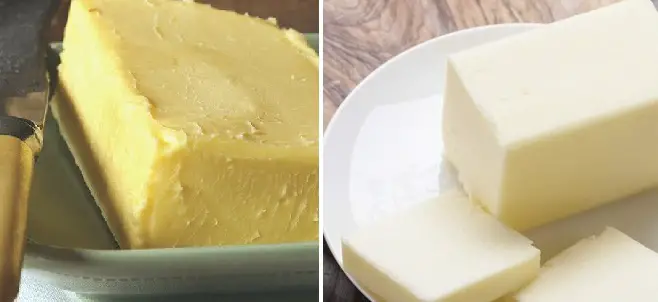
A comparison between what pasture raised butter looks like on the left vs. “organic” butter on the right.
Thanks in large part to the social media revolution, organic produce, healthcare, personal products, and food products are becoming more popular than ever before, with consumers seeking to avoid genetically modified ingredients, synthetic pesticides and other potentially damaging substances.
But all of this growth in organics raises a host of questions, including the ever-present concern of where exactly all of these organic ingredients are coming from, considering that United States farmland is still dominated by “conventional” farming operations.
In the case of butter, there is one brand in particular that has taken the grocery store world, and the health food store world by storm: Kerrygold grass-fed Irish butter.
Recently, Kerrygold was questioned over one aspect of its supply chain, and Paleo foods expert Mark Sisson gave an answer that is sure to get people talking.
“Organic” Butter vs. Grass Fed Butter: Weighing the Pros and Cons
The topic at hand for Sisson was Kerrygold and whether or not it’s still worth buying considering the company admitted recently that the diets of its grass-fed cows may contain as much as 3% GMO feed.
That’s the bad news.
The good news is that Kerrygold’s cows still graze on the fresh, green grasses of rolling hills and pastures in Ireland for almost 90% of their diets, in accordance with what cows have eaten for generations as part of their healthiest, species-specific diet.
“People need to stop chasing dietary perfection,” Sisson said in a recent blog post.
“So Kerrygold cows may get a maximum of 3% of their food from GM soy and/or corn? Is that really a problem?
“90% of their diet comes from Irish grass,” he continued.
“Those Irish Spring soap commercials from the 90s with ridiculously green grass? Cows are gorging themselves on that stuff. For 312 days out of the year, they’re eating wild cow salad and living the dream. And when they’re not, when fresh grass isn’t available, they’re still getting the vast majority of their calories from dried and fermented grass harvested the previous season.”
So, are Kerrygold and other pasture raised butter brands better than organic ones that may be 100% GMO free?
Dark Yellow vs. Pale Yellow: When It Comes to Butter, There’s No Comparison
While I am not a fan of Kerrygold potentially using GMOs as part of its cattle feed (an issue that another health personality, Dave Asprey, recently addressed with a petition to change, although nothing ever came of it), I am a big fan of eating the higest quality butter.
And there’s one area in particular where this type of butter outshines the competition: in its dark, rich, yellowy color.
Over the past several years, I have tried countless varieties of organic and grass-fed butter, and nothing comes close to the dark yellow color of Kerrygold.
So, why is that important, you might be asking?
The answer lies in one key nutrient that “plays a critical role in the normal formation and maintenance of the heart, lungs, kidneys and other organs,” according to a 2020 fact sheet for professionals from the National Institutes of health: beta carotene.
Aside from the above potential benefits, beta carotene also may help in the following areas according to Healthline:
-Reproductive health
-Protection against cell damaging free radicals, as it is an antioxidant by nature
-Reduced risk of chronic diseases, including age-related macular degeneration (AMD), type 2 diabetes, and certain cancers
-Assistance for immune function, vision, and the health of your skin, teeth and bones
Unfortunately, many organic and “natural” butters found on store shelves are practically devoid of this highly beneficial yellow pigmented nutrient, because cows in the United States are fed a diet of mostly grains rather than their natural diet of grass.
Sadly, even organic butter can come from cows fed an unnatural diet of grains, and many are hardly ever even let out to graze on grass.
The result is a pale yellow color that almost looks white in nature, containing far less beta carotene than grass-fed butter products.
Sisson broke it down further in his aforementioned blog post.
“Studies on pastured (not 100% grass-fed and finished) dairy products confirm that “merely” pastured is plenty good enough,” he wrote.
“Just recently, a study placed rodents on one of two diets: a diet high in pastured cream or a diet high in conventional cream. Animals on the high-pastured cream diet had lower body fat, better blood lipids, lower inflammation in body fat tissue, and less liver fat despite eating more calories overall.
“Furthermore, the pastured cream reduced intestinal permeability,” a growing problem in the United States due to Roundup and other factors.
Ultimately the choice between pastured butter and so-called organic butter is a clear one, according to the top selling author and Paleo diet expert.
He encourages consumers to seek out pasture raised butter like Kerrygold whenever possible, and to verify its quality by its look and texture first.
“Give it a squeeze. You can’t; it’s rock hard. Give it a look; it’s white with maybe a tinge of pale yellow,” Sisson said about the organic butter, in comparison to the beta carotene rich butters on the market such as Kerrygold of grass-fed, pasture raised ghee.
“Now give it a nibble; it melts into grease, not creamy velvet. When it comes to butter, the organic part doesn’t matter nearly as much as the grass-fed part.”
As anyone who’s invested heavily in their diet knows, the devil is in the details; and when it comes to butter, the color of your butter may be the most important detail to focus on of them all.
Thanks for installing the Bottom of every post plugin by Corey Salzano. Contact me if you need custom WordPress plugins or website design.





